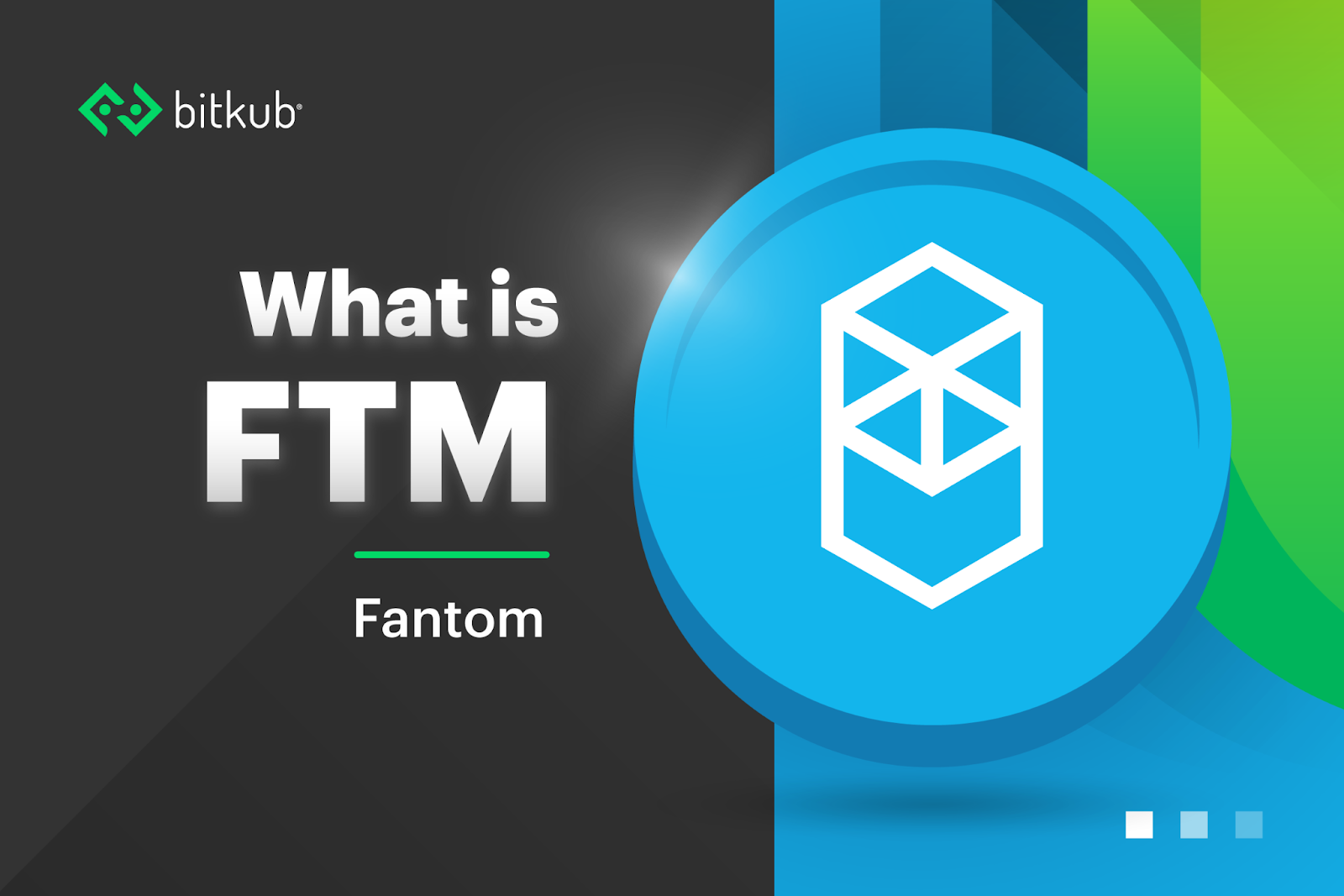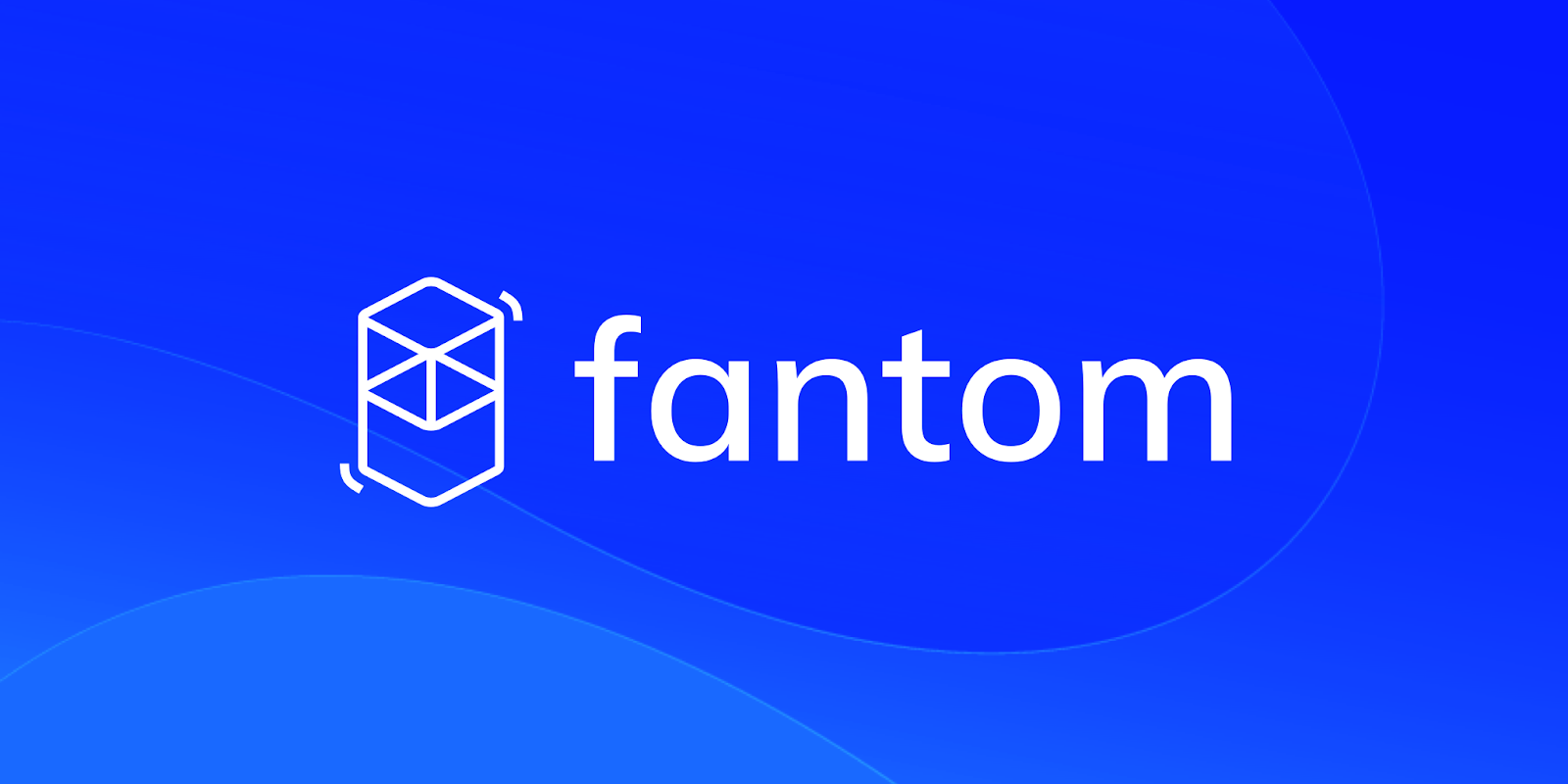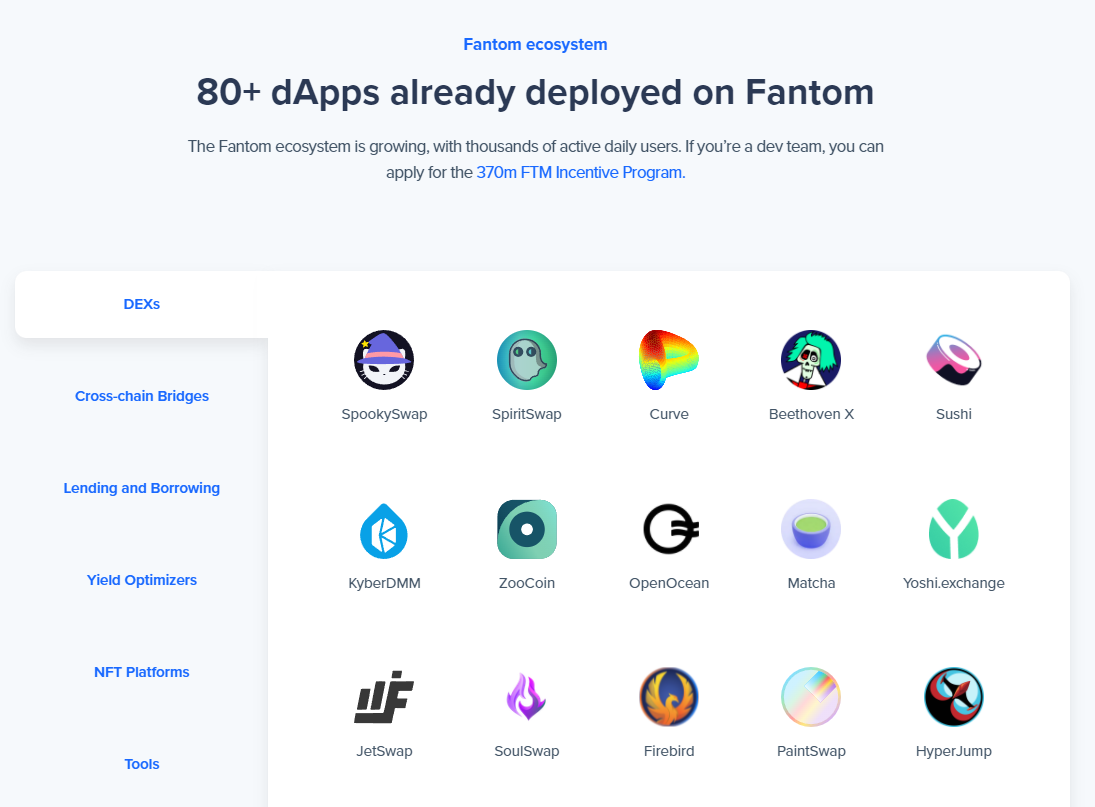บทความ
รู้จัก FTM อีกหนึ่งเครือข่าย Smart Contract รุ่นใหม่ที่มาแรงที่สุด

ปัจจุบัน การแข่งขันระหว่างเครือข่ายคริปโทเคอร์เรนซีรุ่นใหม่ ๆ ที่สามารถใช้ Smart contract ได้อย่าง Avalanche หรือ Solana ถือว่ากำลังดุเดือดเลยทีเดียว และอีกหนึ่งเครือข่ายที่มาแรงและน่าจับตาไม่แพ้กัน นั่นคือ Fantom หรือ FTM นี่เอง
หากคุณกำลังสงสัยว่า เหรียญ FTM คืออะไร, เครือข่าย Fantom เจ๋งอย่างไร หรือกำลังต้องการศึกษาข้อมูลเพิ่มเติมเกี่ยวกับ Fantom คุณมาถูกที่แล้ว เรามาเรียนรู้เกี่ยวกับ Fantom กันได้ที่บทความนี้เลย!
Fantom (FTM) คืออะไร?

Fantom คือเครือข่ายที่รองรับการสร้าง Smart contract เพื่อพัฒนา Decentralized Application (dApp) หรือ Decentralized Finance (DeFi) รวมถึงรองรับสินทรัพย์ประเภท NFT (Non-Fungible Token) โดยมีจุดเด่นที่ความรวดเร็ว ปลอดภัย และมีค่าธรรมเนียมในระดับที่ต่ำมาก เนื่องจาก Fantom มีโครงสร้างเครือข่ายแบบ DAG ร่วมกับการใช้ระบบฉันทามติของตัวเองที่ชื่อว่า Lachesis

ปัจจุบัน Fantom มีโปรเจกต์ dApp และ DeFi ที่สร้างขึ้นบนเครือข่ายมากกว่า 80 โปรเจกต์ โดยมีโปรเจกต์ที่น่าสนใจอย่าง Curve และ SushiSwap ที่อยู่บน Ethereum ก็มาสร้างบน Fantom ด้วยเช่นกัน
เหรียญ FTM คืออะไร?
FTM คือเหรียญหลักของเครือข่าย Fantom ใช้สำหรับการจ่ายค่าธรรมเนียมบนเครือข่ายเมื่อมีการโอนทรัพย์สิน หรือใช้งาน dApp และ DeFi รวมถึงเป็นรางวัลสำหรับผู้ที่ล็อกเหรียญ (Stake) ไว้ในเครือข่ายเพื่อช่วยตรวจสอบธุรกรรม และมอบสิทธิ์ให้ผู้ถือสามารถมีส่วนร่วมกับการบริหารเครือข่ายได้อีกด้วย
นอกจากนี้ เหรียญ FTM ยังมีเป็นโทเคนที่เป็นมาตรฐาน ERC20 บนเครือข่าย Ethereum และ BEP-20 บนเครือข่าย BNB Smart Chain ด้วยเช่นกัน
จุดเด่นของ Fantom
Fantom ไม่ใช่บล็อกเชน แต่เป็น DAG (Directed Acyclic Graph) ซึ่ง DAG มีความแตกต่างกับบล็อกเชนคือ DAG มีการเชื่อมต่อแต่ละบล็อกในเครือข่ายเป็นลักษณะคล้ายใยแมงมุม ขณะที่บล็อกเชนจะเป็นการเชื่อมต่อแบบเส้นตรง ต้องรอให้บล็อกก่อนหน้าได้รับการยืนยันก่อนจึงจะสามารถดำเนินการบล็อกถัดไปได้ ในขณะที่ DAG สามารถตรวจสอบและยืนยันข้อมูลแต่ละบล็อกได้แบบคู่ขนาน ทำให้ Fantom มีความเร็วในการยืนยันธุรกรรมที่สูงกว่าเครือข่ายบล็อกเชนทั่วไป
Fantom ใช้ระบบฉันทามติ (Consensus Algorithm) ที่ปรับปรุงมาจาก aBFT (Asynchronous Byzantine Fault Tolerance) ในชื่อ Lachesis (ลา-คี-ซิส) ซึ่ง aBFT เป็นระบบที่แตกแขนงออกมาจาก BFT (Byzantine Fault Tolerance)
หากสงสัยว่า Byzantine Fault Tolerance คืออะไร สามารถอธิบายได้ง่าย ๆ ว่า BFT เป็นระบบที่ทำให้เครือข่ายสามารถบรรลุข้อตกลงร่วมกันได้ แม้บางบางโหนดในเครือข่ายมีพฤติกรรมที่น่าสงสัย แต่ BFT ใช้เวลาค่อนข้างสูง เพราะต้องรอให้ทุกโหนดตอบกลับมา ในขณะที่ Asynchronous Byzantine Fault Tolerance ไม่จำเป็นต้องรอทุกโหนดตอบกลับมาก็สามารถบรรลุข้อตกลงได้ ทำให้เครือข่ายสามารถประมวลผลและยืนยันธุรกรรมได้เร็วกว่า
สำหรับวิธีการคัดเลือกโหนดที่จะมาเป็นผู้ตรวจสอบและยืนยันธุรกรรม Fantom ใช้ระบบคล้าย ๆ กับ Proof-of-Stake คือผู้ที่ล็อกเหรียญ (Stake) ไว้ในเครือข่ายจะสามารถร่วมเป็นผู้ตรวจสอบ (Validator) เพื่อช่วยเครือข่ายตรวจสอบและยืนยันธุรกรรม เพื่อรับรางวัลเป็นเหรียญ FTM และทำให้เครือข่ายมีความปลอดภัยมากยิ่งขึ้น
อย่างไรก็ตาม การจะเป็นผู้ตรวจสอบบน Fantom ได้นั้น จำเป็นต้องล็อกเหรียญ FTM อย่างน้อย 500,000 เหรียญ ซึ่งเป็นมูลค่าที่สูงมาก แต่สำหรับผู้ที่มีเหรียญไม่ถึงก็สามารถเข้าร่วมการตรวจสอบผ่านการเลือกตัวแทน (Delegate) ที่เราไว้ใจแทนได้ ซึ่งวิธีนี้จะใช้เหรียญ FTM ขั้นต่ำแค่ 1 เหรียญเท่านั้น ซึ่งการเลือกตัวแทนก็ต้องล็อกเหรียญไว้เช่นกัน โดยสามารถเลือกระยะเวลาในการล็อกได้ตั้งแต่ 1 วัน จนถึง 1 ปี รางวัลที่ได้รับก็จะมากขึ้นตามระยะเวลาที่ล็อกเหรียญ
เครือข่าย Fantom ยังรองรับ EVM (Ethereum Virtual Machine) ซึ่งเป็นภาษาที่ใช้สำหรับการเขียน Smart contract เพื่อสร้างเป็นแอปพลิเคชันบน Ethereum ทำให้นักพัฒนาบน Ethereum สามารถย้ายเข้ามาสร้างแอปฯ บน Fantom ได้อย่างง่ายดาย
และด้วยการที่ Ethereum ถือเป็นเครือข่ายบล็อกเชนที่มีนักพัฒนาเยอะที่สุดเครือข่ายหนึ่งในปัจจุบัน การที่ Fantom รองรับ EVM จะยิ่งช่วยผลักดันให้เครือข่ายสามารถเติบโตได้อย่างรวดเร็ว
ผู้สร้าง Fantom

Fantom Foundation คือผู้สร้างเครือข่าย Fantom มีผู้ก่อตั้งคือ Michael Kong ปัจจุบันควบตำแหน่ง CEO (Chief Executive Officer) และ CIO (Chief Information Officer) โดยตัว Michael เองก็เป็นผู้ที่มีประสบการณ์ในวงการบล็อกเชนมาตั้งแต่ ปี ค.ศ. 2016
อีกคนที่น่าสนใจคือ Andre Cronje ผู้สร้าง Yearn Finance หนึ่งในโปรเจกต์ DeFi ที่เป็นตัวจุดกระแสความนิยมใน DeFi โดย Andre ดำรงตำแหน่งเป็นที่ปรึกษาให้กับ Fantom Foundation ซึ่ง Andra ยังได้สนับสนุนให้ Fantom พัฒนาระบบ Multi-chain ให้สามารถสื่อสารกับเครือข่าย Smart contract อื่น ๆ ได้ และยังเป็นผู้ช่วยพัฒนาระบบ Bridge ที่เชื่อมต่อระหว่าง Fantom กับ Ethereum อีกด้วย
การกระจายเหรียญ FTM
อ้างอิงข้อมูลจาก Messari เหรียญ FTM ถูกสร้างออกมาทั้งหมด 3,175,000,000 FTM ตั้งแต่ที่ Mainnet เริ่มต้นทำงานในเดือนธันวาคม ค.ศ. 2019 โดยเหรียญ FTM ถูกกระจายออกไปดังนี้
40% ถูกแบ่งขายให้นักลงทุนกลุ่มแรกทั้งแบบ Public และ Private Sale
15% ถูกแบ่งให้กับกลุ่มที่ปรึกษา โดยเหรียญในกลุ่มนี้จะถูกล็อกไว้เป็นเวลา 3 เดือน
10% ถูกแบ่งให้กับกลุ่มผู้ก่อตั้ง โดยเหรียญในกลุ่มนี้จะถูกล็อกไว้เป็นเวลา 24 เดือน
3.6% ถูกแบ่งเก็บไว้เป็นทุนสำรอง
31.4% ถูกแบ่งเก็บไว้เพื่อเป็นรางวัลสำหรับการล็อกเหรียญ (Staking) โดยจะถูกทยอยปล่อยออกมาจนถึงปี ค.ศ. 2024
อ้างอิง Fantom, Coinmarketcap, Messari
— — — — -
Let’s get to know FTM, one of the new Smart Contract networks
Currently, the competition between the next generation of smart contract-enabled cryptocurrency networks like Avalanche or Solana, another equally hot and exciting is Fantom or FTM.
If you are wondering what FTM coins are, how cool the Fantom network is, and want to learn more about Fantom, you have come to the right place. Let’s learn more about Fantom in this article!
What is Fantom (FTM)?

Fantom is a network that supports smart contract building to develop decentralized applications (dApps) or decentralized finance (DeFi) as well as NFT (Non-Fungible Token) asset classes. This is because Fantom has a DAG-style network structure with the use of its own consensus system called Lachesis.

Currently Fantom has over 80 dApp and DeFi projects built on its network, with some interesting projects like Curve and SushiSwap based on Ethereum also built on Fantom.
What is FTM coin?
FTM is the Fantom network’s flagship coin. It is used for paying fees on the network when transferring assets or running dApps and DeFi, as well as rewarding those who stake their coins on the network to help verify transactions. Not only that, it allows holders to participate in network administration.
The FTM token is also available as a standard ERC20 token on the Ethereum network and BEP-20 on the Binance Smart Chain network.
Outstanding points for Fantom
Fantom is not a blockchain, but a DAG (Directed Acyclic Graph). DAG differs from blockchain in the way that DAG connects each block in the network in a cobweb; while, blockchain will be a linear connection. It has to wait for the previous block to be confirmed before the next block can be executed. The DAG can process and verify individual blocks of data in parallel, which makes Fantom have a higher transaction confirmation speed than the other common block networks.
Fantom uses a Consensus Algorithm based on aBFT (Asynchronous Byzantine Fault Tolerance) called Lachesis.
In the case that you are wondering what Byzantine Fault Tolerance is, it is easy to explain that BFT is a system that enables networks to reach consensus. When some nodes in the network behave suspiciously, BFT takes quite a bit of time. It must wait for all nodes to respond, while Asynchronous Byzantine Fault Tolerance does not need to wait for every node to respond to reach an agreement. This allows the network to process and verify transactions faster.
For its method of selecting nodes to process and verify transactions, Fantom uses a system similar to Proof-of-Stake. A person who locks a coin (Stake) in the network can become a validator to help the network process and verify transactions, in order to win FTM coins and make the network more secure.
However, to become a reviewer on Fantom, you need to lock at least 500,000 FTM coins, which is a very high value. For those who don’t have enough coins, they can participate in the audit through the selection of agents (Delegate) that can be trusted instead. This method uses a minimum of 1 FTM coin. The selection of agents has to lock the coin as well. Individuals can choose the lock duration from 1 day to 1 year. The reward will be increased according to the lock duration.
The Fantom network also supports EVM (Ethereum Virtual Machine), the code used for writing smart contracts to build applications on Ethereum, making it easy for Ethereum developers to move in and build apps on Fantom.
Along with the fact that Ethereum being one of the most developer-rich blockchain networks to date, Fantom’s support for EVM will further drive the network’s rapid growth.
Who created Fantom?

The Fantom Foundation is the creator of the Fantom network, founded by Michael Kong, currently serving as CEO (Chief Executive Officer) and CIO (Chief Information Officer), since 2016.
Another interest is Andre Cronje, creator of Yearn Finance, one of the most popular DeFi projects in DeFi. Andre served as a consultant for the Fantom Foundation, where Andra also encouraged Fantom to develop a multi-chain system. It is able to communicate with other smart contract networks and is also helping to develop a bridge system connecting Fantom and Ethereum.
The distribution of FTM
According to Messari, all FTM coins were created. 3,175,000,000 FTM since Mainnet started operations in December 2019. FTM coins are distributed as follows:
40% is sold to the first group of investors, both public and private sale.
15% is shared with the advisory group. The coins in this group will be locked for 3 months.
10% is shared with the founders Coins in this group will be locked for 24 months.
3.6% are allocated as reserves.
31.4% is shared as a reward for staking, with the release being gradually released until 2024.
References: Fantom, Coinmarketcap, Messari
ที่มา:
Medium